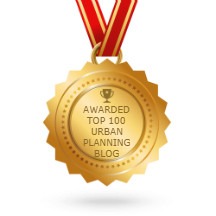(Urban) Grocery Shopping
 The Giant Supermarket at Tivoli Square in Columbia Heights. Photo taken last July.
The Giant Supermarket at Tivoli Square in Columbia Heights. Photo taken last July.People are still grousing about Giant Supermarket having to give up their illegally seized "driving lane" in the middle of the sidewalk, whereas I think of this as a great and rare victory for advocates for quality public spaces. Here's some of what I wrote about this on the Columbia Heights e-list (slightly edited and augmented with a couple of additional photos).
Why do you need a driving lane for an urban grocery store? Why isn't a parking structure, built with a significant amount of city-provided funds, sufficient?
This is a city, not a suburb, and architecture and design should place people, not cars, first.
I highly suggest you request a copy of the book Urban Design Compendium from English Partnerships. It's free.
As a city resident, it's incumbent on you to learn something about urban design if you are going to weigh in on urban design and land use issues in an informed and deliberative fashion.
 The Fox and Obel Supermarket, Chicago -- doesn't need a driving lane and they do just fine. (They have access to a parking lot, just like the Giant at the Tivoli has access to a parking structure physically connected to their building.)
The Fox and Obel Supermarket, Chicago -- doesn't need a driving lane and they do just fine. (They have access to a parking lot, just like the Giant at the Tivoli has access to a parking structure physically connected to their building.) Neither does the Harvest Urban Market in San Francisco. (San Francisco Chronicle photo.)
Neither does the Harvest Urban Market in San Francisco. (San Francisco Chronicle photo.) Nor the Shaw Supermarket at Prudential in Boston.
Nor the Shaw Supermarket at Prudential in Boston.I don't think that Columbia Heights is some magical exception to how cities work or how urban design is supposed to function and connect.
Ironically, just the other day I wrote a blog entry about "suburban creep" of odd and/or inappropriate design, architecture, or use into the urban context. Your statement is a perfect example of being enveloped in a suburban-centric planning and land use paradigm, and speaks volumes about "suburban creep."
From the second email--
Re: "Henock, before you say "Good Job to all that demanded this change" , have you really looked at what they've done? We're left with a huge wide BARREN sidewalk, now what? -- Geniuses that wanted this, do you have any ideas?"
Uh, I guess I'm a "jean-yuss."
 Andronico's Supermarket, Walnut Creek, California. (I didn't use the Whole Foods picture because I don't really like the style of the furniture they use.)
Andronico's Supermarket, Walnut Creek, California. (I didn't use the Whole Foods picture because I don't really like the style of the furniture they use.) Eddies Market, Charles Village, Baltimore.
Eddies Market, Charles Village, Baltimore. Whole Foods Patio and Playscape, Austin, Texas, under construction. (Austin American-Statesman photo.)
Whole Foods Patio and Playscape, Austin, Texas, under construction. (Austin American-Statesman photo.) I mean, even Nordstrom's understands that since they abut the most active public space in Portland, Oregon, that it makes sense to open up to the street somehow, and sell people stuff, in this case, espresso. (Across from Pioneer Courthouse Square.)
I mean, even Nordstrom's understands that since they abut the most active public space in Portland, Oregon, that it makes sense to open up to the street somehow, and sell people stuff, in this case, espresso. (Across from Pioneer Courthouse Square.)The problem really is that Giant Supermarket doesn't appear to be capable of operating outside of their suburban paradigm.
This isn't exclusive to Giant. I think that Safeway has the same problem. Even though they tout their Downtown Portland Oregon store as an urban model, and true, it has glass and activities on the facades, it doesn't use the streetscape at all.
 Safeway, Downtown Portland, Oregon.
Safeway, Downtown Portland, Oregon.They have a Starbucks, but it doesn't open to the street, you have to go inside. They sell flowers on the perimeter of their store, but you have to go inside. They prepare food along one streetside, but the staff and the facility is placed in such a way that they have their backs to the street, etc.
 Potential patio, wasted, at the Safeway in Downtown Portland, Oregon. Contrast that to Nordstrom's Department Store just a few blocks away.
Potential patio, wasted, at the Safeway in Downtown Portland, Oregon. Contrast that to Nordstrom's Department Store just a few blocks away.If I had access to that much patio space, I could make a fortune off it.
 Zupan's in Portland sells flowers outside their store.
Zupan's in Portland sells flowers outside their store. For example, while Whole Foods has their pizza station in Austin, Texas inside the store, on a street that is highly pedestrianized in an urban setting like the Tivoli Square Giant, I'd put it on the street. (Austin American-Statesman photo.)
For example, while Whole Foods has their pizza station in Austin, Texas inside the store, on a street that is highly pedestrianized in an urban setting like the Tivoli Square Giant, I'd put it on the street. (Austin American-Statesman photo.)I'd call up Giant's new consumer affairs person, and set up a meeting.... Although this might require someone with the heft of Odonna Matthews able to talk with "the guys." (See The Face of Giant's Comeback Strategy from the Post about Giant/Stop and Shop's new VP for Consumer Affairs.)
Then the comment was made that I was proposing an urban disneyland. So of course I responded:
Urban "Disney" started in Europe, oh, in the 1500s? Connecting to and benefiting from the street started long before Disneyland was built in the 1950s. Look up the history of how Lloyd's of London was created, out of guys meeting at a coffee shop.
In the U.S., retail developed around food markets, and food markets started outside and then indoor facilities (public markets) were constructed. In many cities, retail districts, including department stores, developed around the market area. While not true of DC, this was true of Baltimore and the Lexington Market.
If you really need to be convinced of this, go check out Philadelphia's Italian Market, or walk through various neighborhood commercial districts in Manhattan, Brooklyn, and Queens. (I don't know Staten Island, so I can't comment on it.)
Since capitalism is all about the commodification of authenticity, I'm surprised that you're so resistant. Me, I just want to see businesses connect to the street, rather than a f*u* to the street. And I am hardly against capitalism (although I am against the commodification of "use value"). If I were, I wouldn't be opening a restaurant-gourmet to go place with horrors (hopefully)--a patio and some food production in one of the windows, in order to build interest and activate the street.
 Flickr photo of Philadelphia's Italian Market by Kagogo.
Flickr photo of Philadelphia's Italian Market by Kagogo. 63rd Avenue in Queens offers more active streetscape-oriented shopping than most any street in DC. And it's merely a neighborhood commercial district, granted, in an area with a lot of population, and ethnicities (especially Jewish immigrants from the old SSRs).
63rd Avenue in Queens offers more active streetscape-oriented shopping than most any street in DC. And it's merely a neighborhood commercial district, granted, in an area with a lot of population, and ethnicities (especially Jewish immigrants from the old SSRs).So the response to this email was that the Lloyd's coffee shop people spent their time figuring out how to finance slavery. I didn't bother responding to that one. And another person made a point that the Columbia Heights Public Realm Plan needs to be focused upon and implemented, but cautioned that creating a patio at the Giant, given current conditions, could be problematic.
I wrote "Good uses can crowd out bad. If that area functioned more like a patio, you would be amazed at the transformation. You don't move forward by cowering."
 Think of the patio area by the Cosi-theaters at Dupont Circle South. (Image from Meetup.)
Think of the patio area by the Cosi-theaters at Dupont Circle South. (Image from Meetup.)Our limited imaginations don't help us make the most of our city.



0 Comments:
Post a Comment
<< Home